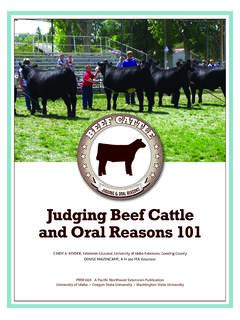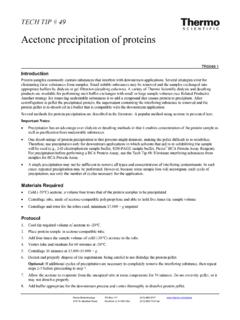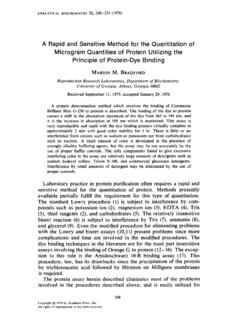Transcription of Nutrients Plants Require for Growth - uidaho.edu
1 Plants Require 17 essential elements for Growth :carbon (C), hydrogen (H), oxygen (O), nitrogen(N), phosphorus (P), potassium (K), sulfur (S), cal-cium (Ca), magnesium (Mg), boron (B), chlorine(Cl), copper (Cu), iron (Fe), manganese (Mn),molybdenum (Mo), nickel (Ni), and zinc (Zn).These 17 essential elements, also called Nutrients ,are often split into three groups (fig. 1). The firstgroup is the three macronutrients that Plants canobtain from water, air, or both carbon (C),hydrogen (H) and oxygen (O). The soil does notneed to provide these Nutrients , so they are not soldas other 14 essential elements are split into twogroups soil-derived macronutrients and soil-derived micronutrients. This split is based on theactual amount of nutrient required for adequateplant Growth . The soil-derived macronutrients arenitrogen (N), phosphorus (P), potassium (K), sulfur(S), calcium (Ca), and magnesium (Mg).
2 The soil-derived micronutrients are boron (B), chlorine (Cl),copper (Cu), iron (Fe), manganese (Mn), molybde-num (Mo), nickel (Ni), and zinc (Zn).Soil-derived macronutrientsThe six soil-derived macronutrients are present inplants at relatively high concentrations normallyexceeding percent of a plant s total dry translates into a minimum need of 20 poundsof each macronutrient per acre each Plants Require large amounts of nitro-gen for adequate Growth . Plants take up N fromthe soil as NH4+(ammonium) or NO3-(nitrate) (table1). A typical plant contains percent nitrogen ona dry weight basis, but this can range from per-cent for a woody plant to up to percent for is a component of amino acids, whichlink together to form proteins. Nitrogen is also acomponent of protoplasts and enzymes (table 2).Once in the plant, N is mobile it can move fromolder plant tissue to new tissue.
3 Consequently, if Nis deficient in Plants , the older leaves often turnyellow-green or yellow first. As the deficiency pro-gresses the entire plant major natural source of N in soils is organicmatter (table 3). Nitrogen is the nutrient generallymost limiting in agronomic, horticultural, andhome and garden situations in the A typical plant contains percentP on a dry weight basis (table 1); however, depend-ing on the plant species this value can range fromCIS 1124 University of Idaho Extension Idaho Agricultural Experiment StationNutrients Plants Requirefor Growthby Robert L. MahlerTable 1. Uptake form and typical plant content of the 14 soil-derived essential content (dry weight)Essential nutrient Uptake formAverageRange%NitrogenNO3-,NH4+ ,HPO42-, + + + , H2BO3-HBO32-202-100 ChlorineCl-10080-10,000 CopperCu2+62-20 IronFe2+10050-1,000 ManganeseMn2+ +<<< + to percent.
4 Plants take up P as an anion(ion with a negative charge) H2PO4- ,HPO42-, orPO43-. The actual form of the anion is dependent onsoil is mobile within Plants and can travelfrom old plant tissue to new plant tissue ondemand (table 2). P deficiency in Plants is hard todiagnose by eye because deficiency symptoms arenot commonly visible. A phosphorus-deficientplant is likely to be dark green but have stuntedgrowth. Phosphorus is essential for ADP, AMP, andbasal metabolism in Plants . Phosphorus deficiencies in soils can be diagnosedwith a soil test. Phosphorus availability is related tosoil pH. In general, soils with pH values and have adequate levels of plant availableP. However, P availability is much lower in soilswith pH values below or above (table 3).Potassium Plants typically contain percent Kon a dry weight basis (table 1). This value canrange from to percent depending on theplant species.
5 Potassium is held by the clays in soilsand is taken up by Plants as K+.Potassium is mobile in Plants (table 2). Potassiumdeficiencies can be diagnosed by looking at theolder plant tissue. Deficiencies appear along theouter margins of older leaves as streaks or spots ofyellow (mild deficiencies) or brown (severe deficien-cies). Potassium plays several roles in Plants . It isimportant for water and energy relationships andhas been linked to improved cold in the Pacific Northwest generally containadequate amounts of potassium (table 3).Deficiencies are isolated to soils where alfalfa andpotatoes have been grown for several Plants take up S from the soil as SO42-, (sul-fate) (table 1). Because the plant-available form ofS is negatively charged, it can be leached out ofplant root zones with precipitation or irrigation. Atypical plant contains percent S on a dryweight basis, but this can range from to , like N, is a component of some amino acidsthat link together to form proteins.
6 Sulfur is also acomponent of plant protoplasts and enzymes(table 2). Once in the plant, sulfur has only fairmobility. New plant tissue will show a sulfur defi-ciency first, often turning yellow-green or and mobility within plant tissue of the 14 soil-derived essential Nutrients for plant nutrientMobility in plantFunction of plantNitrogengoodproteins, protoplasts, enzymesPhosphorusgoodATP,ADP,basal metabolismPotassiumgoodwater relations, energy relations, cold hardinessSulfurfair/goodproteins, protoplasts, enzymesCalciumvery poorcell structure, cell division, cell elongationMagnesiumgoodchlorophyll, enzymesBoronvery poorsugar translocation, cell development, Growth regulatorsChlorinegoodphotosynthesisCopp erpoorenzyme activationIronpoorchlorophyll synthesis, metabolism, enzyme activationManganesepoorHill reaction-photosystem II, enzyme activationMolybdenumpoornitrogen fixation, nitrogen useNickelunknowniron metablismZincpoor protein breakdown.
7 Enzyme activationMacronutrientsfrom water/airMacronutrientsfrom soilsMicronutrientsfrom soilsC, H, ON, P, K,Ca, Mg, SB, Cl, Cu,Fe, Mn, Mo,Ni, ZnFigure 1. There are 17 essential plant Nutrients required forplant is widely deficient in soils in the PacificNorthwest (table 3). Low levels of soil organic mat-ter or excessive watering can produce deficiencies. Calcium A typical plant contains percent Caon a dry weight basis (table 1). However, woodyplants may contain up to percent Ca. Plantstake up calcium as Ca2+. Calcium is required forcell division, cell elongation, and cell structure(table 2). Since Ca is not mobile in Plants , calciumdeficiency symptoms appear at their growing in the Pacific Northwest contain plenty of cal-cium (table 3). Consequently, calcium deficienciesin Plants grown under agronomic, horticultural, orlawn and garden situations have never beenobserved in the Plants typically contain percentMg on a dry weight basis (table 1).
8 This value canrange from to percent depending on theplant species. Magnesium is held by the clays andorganic matter in soils and is taken up by Plants asMg2+.Magnesium is mobile in Plants (table 2).Magnesium deficiencies can be diagnosed by look-ing at the older plant tissue. Deficiencies appear as interveinal chlorosis in older leaves the veins ofthe leaves stay dark green while the areas betweenthe veins appear yellow-green, yellow, or is a component of soils in the Pacific Northwest contain ade-quate amounts of Mg for plant Growth (table 3).Magnesium deficiencies are isolated to soils withpH values below micronutrientsThe eight soil-derived micronutrients are present inplants at relatively low concentrations often justa few parts per million (ppm) of a plant s total dryweight. Even though Plants Require only smallamounts of micronutrients, a deficiency will harmthem as much as a lack of N or P.
9 Plants need 2 pounds per acre of most micronutrients Plants Require about 20 ppm of B (table 1).Boron is taken up by Plants as an uncharged mole-cule (H3BO3) or as an anion (H2BO3-, HBO32-). Sincethe plant-available form of B is not positivelycharged it can be leached out of soils and is oftenlost from the plant root zone by overirrigation orhigh promotes the translocation of sugars andcell development and is believed to be importantfor Growth regulators (table 2). Boron is not mobilein Plants . Consequently, B deficiency symptomsmost often appear on the growing tip of the B-deficient Plants , the growing tip is that contain less than percent organicmatter or are overirrigated tend to be deficient in B(table 3). Boron deficiencies are common on agro-nomic crops, in fruit trees, and in urban additional information on boron, seeUniversity of Idaho CIS 1085, Boron in Plants generally contain about 100ppm of chlorine (table 1).
10 Plants take up chlorineas Cl-and Require it for photosynthesis (table 2).Chlorine is plentiful in soils in the PacificTable soil content and extent of deficiencies in the Pacific Northwest of the 14 soil-derived essential plant nutrientTypical soil contentExtent of deficienciesNitrogen1-2% organic matter*widespreadPhosphorus1-4 ppm (Morgan soil test)widespread; low pH (< ) soils; high pH (> ) soils4-20 ppm (Olson soil test)Potassium>100 ppmisolated to potatoes, alfalfa, high pHSulfur<10 ppmwidespreadCalciumplentyno problemsMagnesiumplentyminimal ppmlow organic matter soils or high precipitationChlorineplentyno ppmsoils with over 8% organic matterIronplenty in low pH soilshigh pH (> ) soils; ornamentals in urban areasManganeseplentyvery isolatedMolybdenumno soil testwhen growing legumes in soils with pH < soil testno ppmwhere topsoil has been removed* Each 1 percent of soil organic matter will supply between 20 and 22 pounds per acre N for plant in furtherance of cooperative extension work in agriculture and home economics, Acts of May 8 and June 30, 1914, in cooperation with Department of Agriculture.














